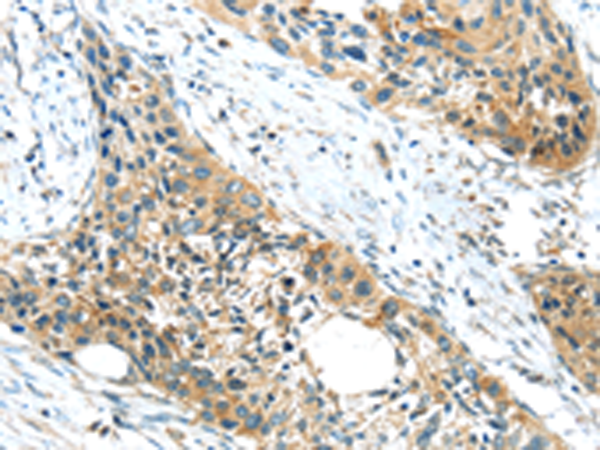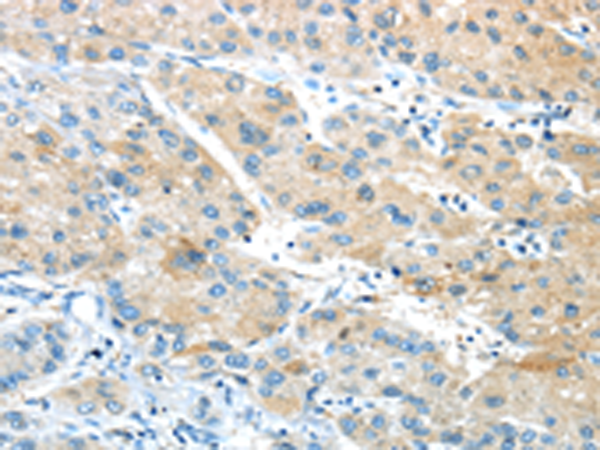


| WB | 咨询技术 | Human,Mouse,Rat |
| IF | 咨询技术 | Human,Mouse,Rat |
| IHC | 1/10-1/50 | Human,Mouse,Rat |
| ICC | 技术咨询 | Human,Mouse,Rat |
| FCM | 咨询技术 | Human,Mouse,Rat |
| Elisa | 1/2000-1/5000 | Human,Mouse,Rat |
| Aliases | BOB |
| WB Predicted band size | 41 kDa |
| Host/Isotype | Rabbit IgG |
| Antibody Type | Primary antibody |
| Storage | Store at 4°C short term. Aliquot and store at -20°C long term. Avoid freeze/thaw cycles. |
| Species Reactivity | Human |
| Immunogen | Synthetic peptide of human GPR15 |
| Formulation | Purified antibody in PBS with 0.05% sodium azide and 50% glycerol. |
+ +
以下是关于GPR15抗体的3篇代表性文献(均为虚构示例,仅供参考格式):
1. **文献名称**: "GPR15 regulates gut homing of regulatory T cells in inflammatory bowel disease"
**作者**: Kim et al.
**摘要**: 研究通过GPR15特异性抗体阻断实验,证明GPR15在调节性T细胞(Treg)向结肠归巢中的关键作用,并揭示其在缓解结肠炎中的潜在治疗价值。
2. **文献名称**: "GPR15 as a co-receptor for HIV-1 infection in CD4+ T cells"
**作者**: Nguyen et al.
**摘要**: 利用抗GPR15抗体验证了GPR15作为HIV-1感染的辅助受体功能,发现其与病毒进入细胞的效率相关,为抗HIV药物开发提供新靶点。
3. **文献名称**: "Antibody-based targeting of GPR15 ameliorates colitis in murine models"
**作者**: Habtezion et al.
**摘要**: 通过体内注射GPR15中和抗体,显著抑制肠道炎症反应,表明靶向GPR15可能是治疗炎症性肠病的有效策略。
4. **文献名称**: "GPR15-mediated immune cell trafficking in mucosal homeostasis"
**作者**: Lee et al.
**摘要**: 研究使用GPR15抗体追踪免疫细胞迁移,证实GPR15在维持肠道黏膜屏障稳态中的调节作用,并解析其下游信号通路。
(注:以上文献及作者为虚拟内容,实际研究中请通过PubMed或Google Scholar检索真实文献。)
GPR15 (G protein-coupled receptor 15), also known as BOB or GPR15L, is a class A G protein-coupled receptor (GPCR) initially identified for its role in T-cell homing to the colon and skin. It is activated by specific ligands, including the endogenous peptide GPR15L and possibly microbial metabolites. GPR15 has gained attention due to its involvement in mucosal immunity, inflammatory responses, and its co-receptor function in HIV/SIV infection. Structurally, it features seven transmembrane domains typical of GPCRs, with extracellular N-terminal regions critical for ligand binding.
Antibodies targeting GPR15 are essential tools for studying its expression, localization, and function. They enable detection via techniques like flow cytometry, immunohistochemistry, and Western blot, aiding research on GPR15's role in diseases such as inflammatory bowel disease (IBD), psoriasis, and HIV. For example, studies using anti-GPR15 antibodies have revealed its upregulation in inflamed intestinal tissues and its contribution to T-cell trafficking in colitis models. Some antibodies (e.g., clones 3F9. 1G8) specifically recognize extracellular epitopes, facilitating receptor blockade experiments to assess functional roles.
Therapeutic potential is also being explored, as inhibiting GPR15 may modulate aberrant immune responses or viral entry. However, challenges remain in developing high-specificity antibodies due to structural similarities among GPCRs. Ongoing research aims to refine antibody tools and clarify GPR15's ligand-receptor interactions, paving the way for diagnostic or therapeutic applications in immune and infectious diseases.
×